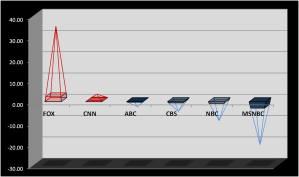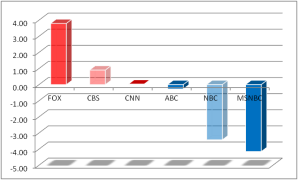Our latest TV News measurement metrics, targeting individual programs aired by the 3 major broadcast networks (ABC, CBS, and NBC) and the top 3 cable news channels (CNN, Fox News, and MSNBC), is fairly consistent with our previous studies. As has been our pattern, we have limited our focus shows airing from 5 PM until 11 PM eastern time, Monday through Friday. Because of that, transcript coverage is less than normal since Florida primary coverage preempted several regular programs under study.
It’s worth noting that, particularly in the case of CNN, those special programs garnered Nielsen ratings of roughly twice the average of the programs they replaced (Erin Burnett Outfront & Anderson Cooper 360). For those who wonder why the media is obsessively covering the Republican primaries, your answer lies there.
As always, content with a numerical rating above zero indicates a Republican slant, with ratings below zero representing a Democratic slant. In this case, however, those shows which are in the +2.0 to -2.0 range are shown in gray, indicating that they are in the “balanced” news category. The one notable exclusion this week is CBS Evening News, but our content coverage for it was exceptionally light. Red remains the color indicator for “slanted” news which favors the Republican party, while slanted content that favors towards the Democratic party is shown in blue. Those interested in the underpinnings of the Mediate Metrics slant rating system should review our January 31st post, or see our primer on Text Analytics Basics at: http://wp.me/p1MQsU-at.
Since our analytical coverage varies by program and date, so does our confidence in the associated show ratings. The exact amount of program coverage is shown in the Table 1 below, but we have graphically indicated depth-of-coverage by way of color shading in Chart 1. For example, the cones representing CBS Evening News, Special Report (Fox), and NBC Nightly News were purposely made lighter to reflect the relatively small transcript coverage for those particular show. We should also note that our version 1.4 classifier did exhibit some anomalies that caused our NBC Nightly News ratings to be disproportionately skewed towards favoring Republicans.
Further information about our rating system can be found in previous posts, or by contacting us via email at: barry@mediatemetrics.com












